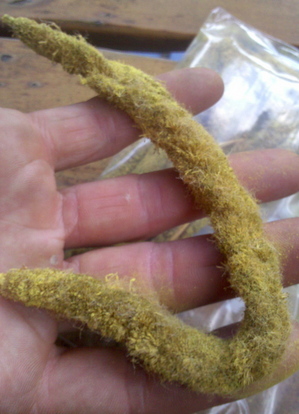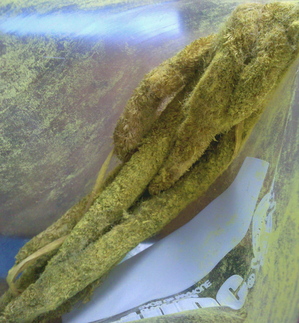Wildcrafting: Capturing cattail’s gold

The male portion of cattail with pollen. When picked, this was mostly brown, and straight. Picking and leaving for a day allows more pollen to develop for harvesting.
Linda Diane Feldt | Contributor
Collecting pollen takes patience, timing, and the cooperation of nature. The recent wind and rainstorms can destroy opportunities, but in the end nature makes allowances for weather. The cattail pollens ripen gradually, in any patch there will be a range of opportunities for the spread of pollen. If it wasn’t so cleverly staggered, a simple rainstorm or heavy wind storm at the wrong time or from the wrong direction would end any chance of sexual reproduction that year.
Cattail pollen is a treasure. It is gold - beautiful to see, sensuous to feel, intriguing to smell, and lovely to taste. And while it is easier to collect than saffron or most other pollens, it still takes a lot of work to get a little pollen.
I’ve tried a few methods to collect it, and have settled on one as most successful. In any cattail group, I break off a couple of the male parts, just beginning to show pollen. I break them off directly into a plastic bag, and move to another group. It’s important for the health of the cattails not to take all of the male parts. But wind will spread a lot of pollen, and a few can certainly be spared.
If you’re not familiar with cattails, the brown tip that gets fuzzy in the fall has a female part below, a bit of a gap or change in texture, and the male part above. With most cattails, each part is 4-8 inches in length, the common cattail has a slight gap between the two parts. Right at that gap or change in texture is where you break off the male part.
But if you are not familiar with cattails, there are some poisonous look-a-likes. For example, Wild Iris. You can positively identify cattail by last year's brown fuzzy tops, the male and female part remaining from the previous season. When in doubt, don't harvest it and don't eat it.
For more photos, and tips for harvesting try this helpful site.
Once collected, let the pollen laid cattail sit in the bag for at least 24 hours. The pollen will fully develop and can be carefully sifted from the rest of the plant. It is obvious which is pollen - it is the golden yellow slippery powder that will pour from the fiberous part.
Now what? Well, using it as flour is traditional. Usually it isn’t a total substitute, but you can replace 30-50 percent of the flour, more or less depending on the kind of recipe. Last year a friend baked up a berry crisp (I recall it was rhubarb and black raspberries) with the traditional oatmeal cut with butter and honey topping. He then sprinkled freshly harvested cattail pollen on top. Not only was it a beautiful dish with the golden finish, the taste of the pollen was very noticeable. It gave it a foreign rich and more flavorful effect.
You can also use the pollen as flour for muffins, pancakes, cornbread, or other simple baked goods. The pollen I now I have I’d like to try as a sort of saffron with brown rice, and see how that goes. Also pollen can be added to yogurt, to smoothies, over whole-grain cereal, or just try it by itself for a treat.

After a day, more pollen is released and this bag has captured the precious grains, ready to be shaken from the plant and eaten in a variety of ways.
Linda Diane Feldt | Contributor
You can also harvest this now and freeze for later consumption. It will last easily about a year. While you can just freeze the whole cattail part, it is much easier to separate it now.
Even as I’m harvesting pollen, I tasted a few shoots earlier today and enjoyed the crisp, sweet, starchy inner core. I will confess that I pulled the cattail from the muck, splashing myself thoroughly with black water as it came up, and just peeled and ate it right there in the marsh. I did share it with two brave novices who seemed startled at the fresh lovely taste. So I’m enjoying cattails just now from both ends!
Linda Diane Feldt is a Holistic Health Practitioner, providing “an integrated approach to holistic health care since 1980” in Ann Arbor. You can follow her on twitter, visit her website, and also attend free monthly classes on a variety of herbal topics through the People’s Food Co-op. Full disclosure: Linda Diane is currently serving as the President of the Board of Directors of The People’s Food Co-op.

